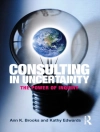Therapists who work with children and adolescents are frequently faced with nonresponsive, reticent, or completely nonverbal clients. This volume brings together expert clinicians who explore why 4- to 16-year-olds may have difficulty talking and provide creative ways to facilitate communication. A variety of play, art, movement, and animal-assisted therapies, as well as trauma-focused therapy with adolescents, are illustrated with vivid clinical material. Contributors give particular attention to the neurobiological effects of trauma, how they manifest in the body when children ‘clam up, ‘ and how to help children self-regulate and feel safe. Most chapters conclude with succinct lists of recommended practices for engaging hard-to-reach children that therapists can immediately try out in their own work.
Jadual kandungan
I. General Principles to Guide Practice
1. Why Children Clam Up in Therapy, Cathy A. Malchiodi & David A. Crenshaw
2. Resistance in Child Psychotherapy: Playing Hide-and-Seek, David A. Crenshaw
3. A Neurosequential Therapeutics Approach to Guided Play, Play Therapy, and Activities for Children Who Won’t Talk, Richard L. Gaskill & Bruce D. Perry
II. Master Clinician Approaches
4. The Sound of Silence in Play Therapy, Anne L. Stewart & Lennis G. Echterling
5. Play Therapy with Children Who Don’t Want to Talk: ‘Sometimes We Talk, and Sometimes We Play, ‘ Nancy Boyd Webb
6. Polyvagal Informed Dance/Movement Therapy with Children Who Shut Down: Restoring Core Rhythmicity, Amber Elizabeth Gray & Stephen Porges
7. Play Therapy through the Lens of Interpersonal Neurobiology: Up and over the
Mountain, Theresa Kestly
8. Treating Adolescent Attachment Trauma: Ten Ways to Co-Regulate and Stay Connected, Martha B. Straus
9. Silencing and the Culture of Sexual Violence: The “Shadow Abuser, ‘ Sarah Caprioli & David A. Crenshaw
10. Art Therapy Approaches to Facilitate Verbal Expression: Getting Past the Impasse, Cathy A. Malchiodi
11. Animal Assisted Play Therapy with Reticent Children: With a Little Help from Friends, Risë Van Fleet & Tracie Faa-Thompson
Index
Mengenai Pengarang
Cathy A. Malchiodi, Ph D, ATR-BC, LPCC, LPAT, REAT, is a psychologist and expressive arts therapist specializing in trauma recovery. Since the 1990s, Dr. Malchiodi has worked with traumatized children, adolescents, adults, and families, expanding the range of understanding of nonverbal, sensory-based concepts and methods. Founder and executive director of the Trauma-Informed Practices and Expressive Arts Therapy Institute, Dr. Malchiodi has given over 700 invited keynotes, lectures, and workshops around the world, and has assisted more than 500 organizations and institutions in developing trauma-informed, expressive arts, and disaster relief programming. Her books include Trauma and Expressive Arts Therapy, Understanding Children’s Drawings, and Creative Interventions with Traumatized Children, Second Edition. Dr. Malchiodi is a contributing writer for Psychology Today, an active visual artist, and an aspiring musician.
David A. Crenshaw, Ph D, ABPP, RPT-S, is Clinical Director of the Children’s Home of Poughkeepsie, New York, and Adjunct Faculty at Marist College. He has taught graduate courses in play therapy at Johns Hopkins University and Columbia University and has published widely on child and adolescent therapy, child abuse and trauma, and resilience in children. A Fellow of the American Psychological Association and of its Division of Child and Adolescent Psychology, Dr. Crenshaw has received lifetime achievement awards from the New York Association for Play Therapy and the Hudson Valley Psychological Association. He is a past chair of the board of directors of the Coalition against Sexual and Domestic Abuse and a member of the professional advisory board of the Courthouse Dogs Foundation and of the Dutchess County Task Force against Human Trafficking.












